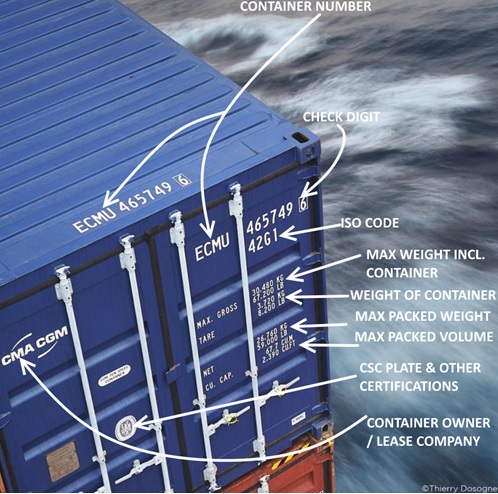Ever driven behind a truck carrying a shipping container on the motorway? Or perhaps maybe you have seen the markings on a container, especially the back door when it comes to your warehouse for packing or unpacking.
Each of these markings represent a very significant role in the transportation of the container and provides vital information to all entities in the supply chain relating to the monitoring and safety of the container and cargo during its carriage from pick up to final place of delivery. Read more to discover what each of the markings actually means.
1) Container Number – is of course the main marking on the door.. It is an alpha numeric sequence made up of 4 Alphabets and 7 Numbers.
The container number identification system has been created by the International Standards Organisation under their code IS06346:1995(E).

As per this code, the container identification system consists of:-
Owner code – 3 letters (in this example ECM)
Equipment category – 1 letter (in our example, U denoting a freight container. Other categories being J for detachable container related equipment (such as Genset) and Z for trailers and chassis).
Serial number – 6 numbers (numbers ONLY)
Check Digit – 1 number (numbers ONLY)
The owner code is unique to the owner of the container and the registration of this code rests with Bureau International des Containers et du Transport Intermodal (BIC).This is to avoid any duplication of code by any shipping line or container operator.
To find the owner of a container, you can always do a BIC Code Search to identify the rightful owner.
However, the owner of the container need not necessarily be operating the container as they could have leased the container to another operator or shipping line.
2) Check Digit – although it is part of the full container number, the check digit is an important number as it can be used to identify if the above mentioned identification sequence is valid or invalid.
For example, if you go to BIC’s Check Digit Calculator and type in the prefix – ECMU and the numbers 465749, see what you get as the Check Digit. It should come up as “6”.
3) Container Owner or Lessor – This is the entity that owns or operates the container. This could be a shipping line, like in this example (CMA CGM Group) or a container leasing company such as SeaCo who’s business is to lease containers to shipping lines that need to increase their inventory but not their assets.
4) Max Gross – In this example – 30,480 Kgs is the maximum weight that the container can carry including its own tare weight of 3,720 kg or 8,200 LB. This is the weight that the SOLAS VGM Certificate must show.
5) ISO Code – As per the International Standards Organisation under their code IS06346:1995(E), each container is given a unique ISO Code in order to avoid any ambiguity in naming the container.
For example, a standard 20′ container is called Dry Van (DV), General Purpose (GP), Standard (SD), Normal, Dry Container (DC) in different countries.
As these terms are all different, these terms cannot be used in uniform systems that are used for transmission of data across ports, customs, shipping lines etc. Therefore as a standard, the ISO code of 42G1 (in the example) is used to denote that the container in question is a 40′ container with a tare weight of 3,720 kgs.























